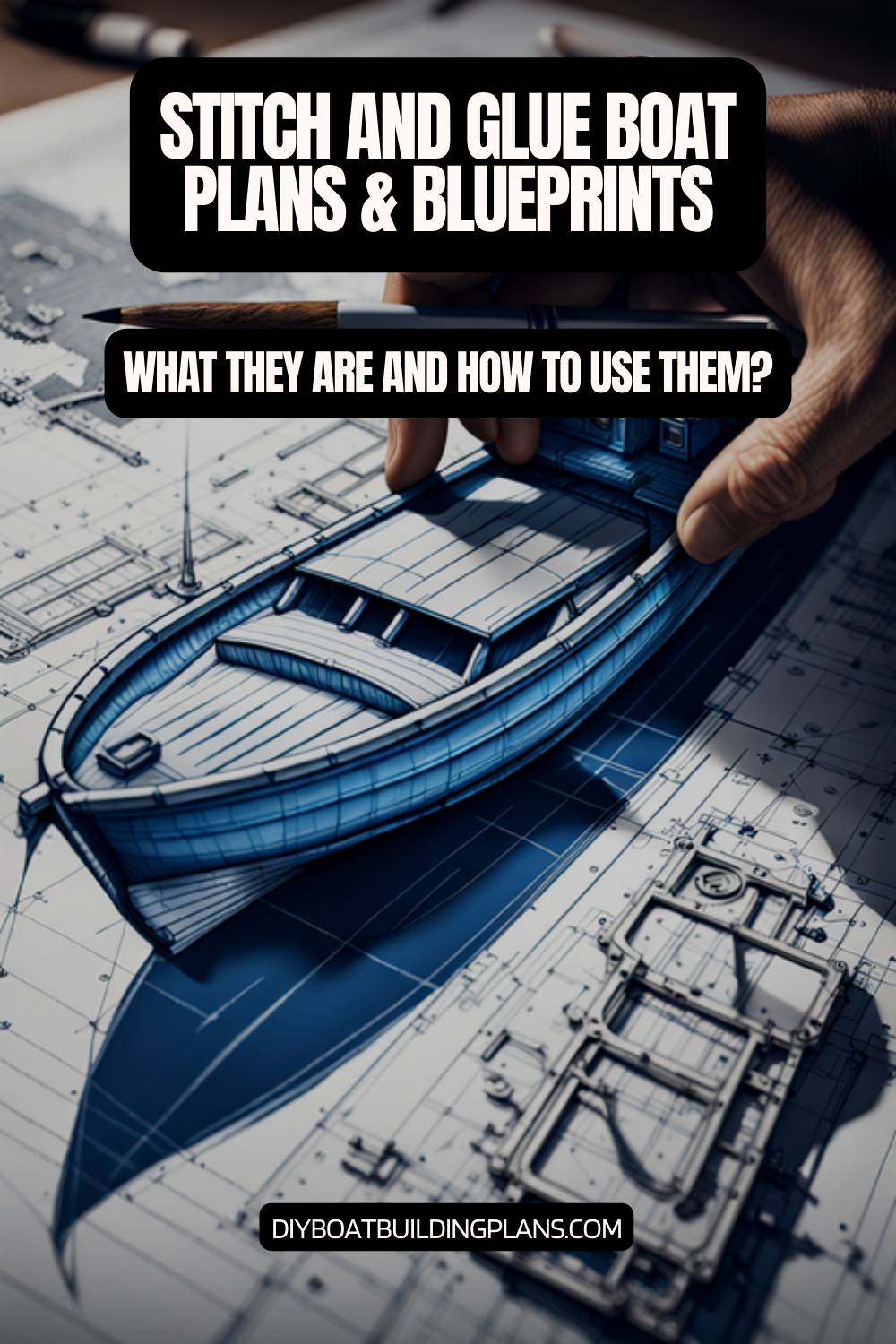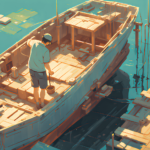Overview of Stitch and Glue Boat Plans & Blueprints
Stitch and glue boat building is a popular and accessible method of constructing boats, offering a unique alternative to traditional boat building techniques. This approach combines the use of thin, flexible plywood panels that are stitched together and then reinforced with epoxy resin, creating a strong and durable boat structure. The stitch and glue method has gained significant popularity among both experienced and novice boat builders due to its simplicity, cost-effectiveness, and the ability to produce a wide range of boat designs.
One of the primary advantages of the stitch and glue method is its accessibility. Unlike traditional boat building, which often requires specialized tools, extensive woodworking skills, and a significant investment of time and resources, the stitch and glue approach is relatively straightforward and can be mastered by individuals with varying levels of experience. This makes it an attractive option for hobbyists, DIY enthusiasts, and those looking to build their own boats without the need for extensive training or a professional workshop.
Furthermore, the stitch and glue method offers several advantages over traditional boat building techniques. The use of thin plywood panels and epoxy resin results in a lightweight yet strong boat structure, which can be particularly beneficial for small to medium-sized vessels. Additionally, the flexibility of the plywood allows for the creation of complex and unique boat designs, enabling builders to explore a wide range of shapes and configurations that may not be feasible with more rigid construction methods.
Key Takeaways
- Stitch and glue boat building is a popular method for constructing small boats.
- Understanding the basics of stitch and glue construction is essential before choosing plans.
- Choosing the right stitch and glue boat plans is crucial for a successful build.
- Preparing your workspace and following a step-by-step guide are important for assembling your boat.
- Finishing touches, troubleshooting common issues, and proper maintenance are key to launching and enjoying your stitch and glue boat.

Understanding the Basics of Stitch and Glue Construction
The stitch and glue construction process involves the assembly of thin plywood panels that are stitched together using wire or synthetic thread and then reinforced with epoxy resin. This process begins with the careful cutting and preparation of the boat panels, which are typically made from marine-grade plywood or other suitable materials. The panels are then stitched together using a series of small holes drilled along the edges, creating a temporary framework that holds the boat’s shape.
Once the panels are stitched, the next step is to apply the epoxy resin. This resin acts as a strong adhesive, bonding the panels together and creating a durable, water-resistant structure. The epoxy resin is typically applied in multiple layers, with each layer allowed to fully cure before the next is applied. This process ensures a strong and long-lasting bond between the panels, resulting in a boat that is both sturdy and lightweight.
The key components and materials used in stitch and glue boat building include marine-grade plywood, epoxy resin, fiberglass cloth or tape, and various tools such as saws, drills, clamps, and stitching materials. The selection of these materials is crucial, as they directly impact the overall strength, durability, and performance of the finished boat. Builders must carefully consider the quality and compatibility of the materials they choose to ensure a successful and satisfying boat-building experience.
Choosing the Right Stitch and Glue Boat Plans
When embarking on a stitch and glue boat-building project, the selection of the right boat plans is a critical decision. There are a variety of factors to consider when choosing the appropriate stitch and glue boat plans, including the intended use of the boat, the builder’s skill level, and the available workspace and resources.
One of the primary considerations when selecting stitch and glue boat plans is the complexity of the design. Some plans may feature relatively simple and straightforward boat designs, while others may be more intricate and challenging. Builders must carefully evaluate their own skills and experience to ensure that they choose a design that aligns with their abilities and is within their comfort level. Selecting a plan that is too complex for the builder’s skill level can lead to frustration, delays, and potentially even structural issues with the finished boat.
Another important factor to consider is the intended use of the boat. Different boat designs are better suited for specific purposes, such as recreational sailing, fishing, or even racing. Builders should carefully consider the activities they plan to engage in with the boat and choose a design that is optimized for those activities. This may involve factors such as the boat’s size, stability, speed, and maneuverability.
Ultimately, the selection of the right stitch and glue boat plans is a crucial step in the boat-building process. By carefully evaluating the complexity, skill level, and intended use of the boat, builders can ensure that they choose a design that is well-suited to their abilities and goals, leading to a successful and rewarding boat-building experience.
Preparing Your Workspace for Stitch and Glue Boat Building
Preparing a suitable workspace is a crucial step in the stitch and glue boat-building process. The workspace should be large enough to accommodate the boat’s dimensions, provide ample space for maneuvering, and offer a clean and organized environment for the construction process.
One of the key considerations when setting up a workspace for stitch and glue boat building is the availability of a flat, level surface. This surface, often referred to as a “building jig,” serves as the foundation for the boat’s construction. It is essential that the building jig is level and sturdy, as any irregularities or instability can negatively impact the alignment and structural integrity of the finished boat.
In addition to the building jig, the workspace should also be equipped with the necessary tools and equipment for the construction process. This may include saws for cutting the plywood panels, drills for creating the stitching holes, clamps for holding the panels in place, and a variety of other tools and accessories. Builders should ensure that they have all the required tools and materials readily available, as this can help streamline the construction process and minimize delays.
Another important consideration when preparing the workspace is the availability of adequate lighting and ventilation. Proper lighting is essential for ensuring accurate measurements, precise cutting, and effective gluing and stitching. Adequate ventilation is also crucial, particularly when working with epoxy resin, as the fumes can be hazardous if not properly managed.
By carefully planning and setting up a suitable workspace, stitch and glue boat builders can create an environment that is conducive to a successful and enjoyable boat-building experience. This preparation can help ensure that the construction process runs smoothly, with minimal interruptions or setbacks.
Step-by-Step Guide to Assembling Your Stitch and Glue Boat
| Plan Name | Price | Difficulty Level | Number of Sheets | Estimated Build Time |
|---|---|---|---|---|
| Stitch and Glue Kayak Plans | 29.99 | Intermediate | 8 | 60 hours |
| Stitch and Glue Canoe Plans | 39.99 | Advanced | 12 | 80 hours |
| Stitch and Glue Dinghy Plans | 49.99 | Expert | 16 | 100 hours |
The assembly of a stitch and glue boat involves a series of carefully executed steps, each of which plays a crucial role in the overall success of the project. The process begins with the cutting and preparation of the boat panels, followed by the stitching and gluing of the components together.
The first step in the assembly process is to carefully cut the plywood panels according to the boat plans. This requires precise measurements and the use of appropriate cutting tools, such as a circular saw or a jigsaw. Builders must ensure that the panels are cut accurately, as any irregularities or discrepancies can affect the final shape and structural integrity of the boat.
Once the panels are cut, the next step is to begin the stitching process. This involves drilling small holes along the edges of the panels and using wire or synthetic thread to temporarily stitch them together. The stitching serves to hold the panels in place while the epoxy resin is applied, creating a temporary framework that maintains the boat’s shape.
With the panels stitched together, the next step is to apply the epoxy resin. This is a critical stage, as the resin acts as the primary adhesive, bonding the panels together and creating a strong, water-resistant structure. The resin is typically applied in multiple layers, with each layer allowed to fully cure before the next is added. Builders must carefully follow the manufacturer’s instructions and take appropriate safety precautions when working with epoxy resin.
Throughout the assembly process, it is essential to ensure proper alignment and structural integrity. This may involve the use of clamps, jigs, or other tools to maintain the desired shape and prevent warping or distortion of the boat’s structure. Builders must also be vigilant in monitoring the curing process and addressing any issues that may arise, such as air bubbles or uneven resin application.
By following a step-by-step guide and paying close attention to the details of the assembly process, stitch and glue boat builders can create a strong, durable, and well-crafted boat that meets their expectations and provides a rewarding and enjoyable boating experience.
Mastering the Art of Stitching and Gluing
The success of a stitch and glue boat-building project is heavily dependent on the mastery of the stitching and gluing techniques. These techniques are the foundation of the construction process, and a thorough understanding of them can make the difference between a well-crafted boat and one that may struggle with structural integrity or performance issues.
Effective stitching is crucial for maintaining the boat’s shape and alignment during the construction process. Builders must carefully plan the placement and spacing of the stitching holes, ensuring that they are evenly distributed and provide adequate support for the boat’s structure. The stitching material, whether it be wire or synthetic thread, must be strong and durable enough to withstand the tension and stress of the construction process.
In addition to the stitching, the gluing process is equally important. The epoxy resin used in stitch and glue boat building must be applied with precision and care, ensuring that it fully penetrates the joints and creates a strong, water-resistant bond between the panels. Builders must be mindful of the resin’s curing time and work efficiently to avoid any issues with uneven or incomplete coverage.
To master the art of stitching and gluing, builders can benefit from a variety of techniques and tips. For example, using a stitching jig or template can help ensure consistent and accurate hole placement, while the use of specialized tools, such as epoxy mixing cups and applicators, can improve the efficiency and quality of the gluing process.
Furthermore, builders should be prepared to troubleshoot and address any issues that may arise during the stitching and gluing stages. This may involve identifying and addressing problems such as air bubbles, uneven resin application, or structural weaknesses. By developing a keen eye for detail and a problem-solving mindset, builders can overcome these challenges and produce a high-quality, durable boat.
Mastering the art of stitching and gluing is a crucial step in the stitch and glue boat-building process. By honing these skills and techniques, builders can create boats that not only look great but also perform exceptionally well on the water.
Finishing Touches: Painting, Varnishing, and Outfitting Your Stitch and Glue Boat
The final stages of a stitch and glue boat-building project involve the finishing touches, which include painting, varnishing, and outfitting the boat. These steps are essential for enhancing the boat’s appearance, protecting its surfaces, and adding the necessary accessories and features to make it fully functional.
Preparing the boat’s surface for painting and varnishing is a crucial first step. This may involve sanding the epoxy resin to create a smooth, even surface, and ensuring that the boat is free from any imperfections or irregularities. Builders must also carefully clean the surface to remove any dust or debris that could interfere with the application of the paint or varnish.
When it comes to selecting the appropriate paints and varnishes, builders have a wide range of options to choose from. Marine-grade paints and varnishes are specifically formulated to withstand the harsh conditions of the aquatic environment, providing long-lasting protection and a beautiful finish. Builders should carefully consider factors such as the desired color, sheen, and level of UV protection when making their selections.
In addition to the paint and varnish, the outfitting of the boat is an important aspect of the finishing process. This may involve the installation of accessories such as oarlocks, cleats, and other hardware, as well as the addition of features like seating, storage compartments, and even electronics or navigation equipment. Builders must carefully plan and execute these installations to ensure that the boat is both functional and aesthetically pleasing.
Throughout the finishing process, attention to detail is paramount. Builders must take the time to carefully apply the paint and varnish, ensuring even coverage and a smooth, professional-looking finish. They must also ensure that the installation of accessories and features is done with precision, maintaining the boat’s structural integrity and overall appearance.
By meticulously completing the finishing touches, stitch and glue boat builders can transform their creation into a truly remarkable and personalized vessel, ready to be launched and enjoyed on the water.
Troubleshooting Common Issues in Stitch and Glue Boat Building
Despite the relative simplicity of the stitch and glue boat-building method, builders may encounter various challenges and issues during the construction process. Identifying and addressing these problems in a timely and effective manner is crucial for ensuring the success of the project.
One of the most common issues that stitch and glue boat builders may face is the occurrence of air bubbles in the epoxy resin. These air bubbles can compromise the structural integrity of the boat and lead to potential leaks or other problems. Builders can address this issue by carefully mixing the resin, applying it in thin, even layers, and using techniques such as vacuum bagging or rolling to remove any trapped air.
Another common problem is the warping or distortion of the boat’s panels during the construction process. This can be caused by a variety of factors, including improper stitching, uneven clamping, or the use of subpar materials. Builders can mitigate this issue by ensuring that the building jig is level and stable, using clamps and jigs to maintain the desired shape, and carefully monitoring the curing process.
In some cases, builders may encounter difficulties with the adhesion of the epoxy resin, leading to delamination or separation of the boat’s components. This can be caused by a variety of factors, such as improper surface preparation, contamination, or the use of incompatible materials. Builders can address this issue by thoroughly cleaning and preparing the surfaces, following the manufacturer’s instructions for the epoxy resin, and potentially seeking the advice of experienced builders or experts.
Regardless of the specific issue, the key to successful troubleshooting in stitch and glue boat building is a combination of patience, attention to detail, and a willingness to experiment and learn from mistakes. Builders should be prepared to document their experiences, seek out resources and guidance from experienced builders, and continuously refine their techniques to overcome any challenges that may arise.
By addressing common issues in a timely and effective manner, stitch and glue boat builders can ensure the successful completion of their projects and the creation of a high-quality, durable, and enjoyable boat.
Launching and Maintaining Your Stitch and Glue Boat
The final step in the stitch and glue boat-building process is the launch and ongoing maintenance of the completed vessel. Proper preparation and care are essential to ensure the longevity and performance of the boat, as well as the safety of the operator and any passengers.
When it comes to launching the stitch and glue boat, builders must carefully consider the logistics and safety aspects. This may involve the use of a trailer or other transportation method to move the boat to the launch site, as well as the selection of a suitable launch ramp or beach. Builders should also be mindful of the boat’s weight and stability, ensuring that it is properly balanced and secured during the launch process.
Once the boat is in the water, the focus shifts to proper maintenance and care. This includes regular inspections of the boat’s structure, checking for any signs of wear or damage, and addressing any issues in a timely manner. Builders should also be diligent in cleaning and protecting the boat’s surfaces, using appropriate cleaning products and applying protective coatings as needed.
Another important aspect of maintaining a stitch and glue boat is the proper storage and transportation of the vessel. When not in use, the boat should be stored in a dry, protected environment, such as a garage or boat shed, to prevent exposure to the elements and minimize the risk of damage. When transporting the boat, builders must ensure that it is securely fastened to the trailer or other transport method, and that the weight and balance are properly distributed.
By following best practices for launching, operating, and maintaining their stitch and glue boat, builders can ensure that their creation continues to provide a safe, enjoyable, and long-lasting boating experience. This commitment to proper care and maintenance is essential for preserving the investment of time, effort, and resources that went into the boat-building process.

Conclusion – Stitch and Glue Boat Plans & Blueprints
In conclusion, stitch and glue boat plans & blueprints offer a practical and accessible approach to boat building, making it an attractive option for both beginners and experienced builders. The key takeaways emphasize the simplicity, speed, affordability, strength, and lightness associated with this construction method.
Download over 500 Boat Plans. Click on the link below.
-->Click Here<--
The comprehensive nature of stitch and glue boat plans, detailing dimensions, hole placements, stitching sequences, epoxy resin applications, and finishing steps, provides builders with a roadmap to create a strong and lightweight hull. The versatility of these plans, available in various formats and from different sources, accommodates a wide range of preferences and budgets.
The benefits of stitch and glue construction, including the minimal tools required, fast building process, and economic use of materials, make it a feasible choice for DIY boat builders. The affordability of standard materials, coupled with the durability of the resulting boats, underscores the practicality of this method.
The historical roots of stitch and glue design, dating back to ancient civilizations but evolving with modern materials in the mid-20th century, highlight its enduring appeal and adaptability. The varied types of stitch and glue boats, each suited to specific water conditions and purposes, further showcase the versatility of this construction technique.
Before embarking on a stitch and glue boat project, careful consideration of factors such as boat type, plan quality, safety measures, and personal skills is crucial. The conclusion reinforces the idea that, with the right plans, a stitch and glue boat can be a rewarding and fulfilling project, connecting modern enthusiasts with a rich maritime tradition.
FAQs – Stitch and Glue Boat Plans & Blueprints
What are Stitch and Glue Boat Plans & Blueprints?
Stitch and Glue Boat Plans & Blueprints are a type of boat building method that involves stitching panels of plywood together with wire, and then gluing them together with epoxy resin. The plans and blueprints provide detailed instructions on how to build a boat using this method.
What types of boats can be built using Stitch and Glue Boat Plans & Blueprints?
Stitch and Glue Boat Plans & Blueprints can be used to build a variety of boats, including kayaks, canoes, dinghies, and small sailboats. The method is particularly well-suited for building small, lightweight boats.
What materials are needed to build a boat using Stitch and Glue Boat Plans & Blueprints?
To build a boat using Stitch and Glue Boat Plans & Blueprints, you will need marine-grade plywood, epoxy resin, fiberglass cloth, wire, and various tools such as a jigsaw, drill, and sandpaper. The plans and blueprints will provide a detailed list of materials and tools needed.
Are Stitch and Glue Boat Plans & Blueprints suitable for beginners?
Stitch and Glue Boat Plans & Blueprints can be suitable for beginners, as long as they have some basic woodworking skills and are willing to follow the instructions carefully. However, it is important to note that building a boat using this method can be time-consuming and requires a significant amount of patience and attention to detail.
Can Stitch and Glue Boat Plans & Blueprints be customized?
Yes, Stitch and Glue Boat Plans & Blueprints can be customized to suit your specific needs and preferences. For example, you can adjust the size and shape of the boat, add or remove features such as hatches or seats, and choose different types of wood or finishes. However, it is important to ensure that any modifications you make do not compromise the structural integrity of the boat.



